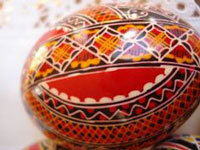Celebrations Ideas, Easter
How to Paint Easter Eggs
DIY Easter Eggs Anthropological studies, almost universally, find the egg to be a symbol of fertility and rebirth, with its artistic manifestations at the core of many religious belief systems. Ritualistic ornamentation of eggs revolved around specific holidays or general celebrations associated with spring. Easter and Lenten egg painting found their roots, in part, in the pre-Christian traditions of the people of northern Europe. Colored eggs of migratory birds returning from warmer climates marked the return of spring to many in the north.
History

Waxing and Dying: The How-to Guide




All you need, really, are patience and a steady hand. That’s it! Keep the egg, or give it, with its inscribed good wishes, to someone as a special token. For the best look, place the eggs in a basket, on Royal Lace Paper Doilies, like in the images shown here.
And, of course, the materials. In addition to eggs and dye, you’ll need some beeswax, a candle and a kistka, a wooden dowel with a small brass funnel attached to one end.
Start with a clean, white, raw egg. Place a small piece of wax into the larger end of the kistka funnel, and hold it in the candle flame. As the wax starts to melt and move toward the smaller end, draw wax lines on your egg.
You’ll be constantly moving back and forth between the candle and the egg, as the wax tends to harden quickly, and you’ll need to keep feeding wax into the kistka, as the funnel is small.
Any area covered with wax at this point will remain white on the finished egg.
Symmetry is key.
When you’ve finished drawing wax lines for your white patterns, place the egg in a jar of dye for five to 10 minutes. Remember to always start with light-colored dyes, such as yellow. When you remove the egg, pat it dry with a paper towel. Next, draw a wax pattern on any part of the egg you wish to remain yellow. Repeat the dying process with a darker dye. Once you’ve finished waxing and dying, let the egg dry completely.
To remove the wax, hold the egg near the middle part of the flame. As the wax begins to melt, quickly (and gently) wipe it off with a clean paper towel. Repeat until all wax is gone.
Later, you can varnish the egg using gloss, varnish or shellac. If your egg has no cracks, it will last safely for years and years, without any smell. (Just rotate it every few months to ensure even drying of the yolk and whites inside.)


 .
.


